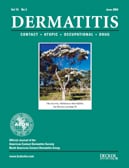
“The endocannabinoid system (ECS) is a recently emerging complex regulator of multiple physiological processes. It comprises several endogenous ligands (e.g. N-arachidonoylethanolamine, a.k.a. anandamide [AEA], 2-arachidonoylglycerol [2-AG], palmitoylethanolamide [PEA], etc.), a number of endocannabinoid (eCB)-responsive receptors (e.g. CB1 and CB2, etc.), as well as enzymes and transporters involved in the synthesis and degradation of the eCBs.
Among many other tissues and organs, various members of the ECS were shown to be expressed in the skin as well. Indeed, AEA, 2-AG, CB1 and CB2 together with the major eCB-metabolizing enzymes (e.g. fatty acid amide hydrolase [FAAH], which cleaves AEA to ethanolamine and pro-inflammatory arachidonic acid) were found in various cutaneous cell types. Importantly, the eCB-tone and cannabinoid signaling in general appear to play a key role in regulating several fundamental aspects of cutaneous homeostasis, including proliferation and differentiation of epidermal keratinocytes, hair growth, sebaceous lipid production, melanogenesis, fibroblast activity, etc.
Moreover, appropriate eCB-signaling through CB1 and CB2 receptors was found to be crucially important in keeping cutaneous inflammatory processes under control.
Collectively, these findings (together with many other recently published data) implied keratinocytes to be “non-classical” immune competent cells, playing a central role in initiation and regulation of cutaneous immune processes, and the “c(ut)annabinoid” system is now proven to be one of their master regulators.
Another recently emerging, fascinating possibility to manage cutaneous inflammation through the cannabinoid signaling is the administration of phytocannabinoids (pCB). Cannabis sativa contains over 100 different pCBs, the vast majority of which have no psychotropic activity, and usually possess a “favorable” side-effect profile, which makes these substances particularly interesting drug candidates in treating several inflammation-accompanied diseases.
With respect to the skin, we have recently shown that one of the best studied pCBs, (−)-cannabidiol (CBD), may have great potential in managing acne, an inflammation-accompanied, extremely prevalent cutaneous disease.
Collectively, in light of the above results, both increase/restoration of the homeostatic cutaneous eCB-tone by FAAH-inhibitors and topical administration of non-psychotropic pCBs hold out the promise to exert remarkable anti-inflammatory actions, making them very exciting drug candidates, deserving full clinical exploration as potent, yet safe novel class of anti-inflammatory agents.”
http://www.ebiomedicine.com/article/S2352-3964(17)30003-8/fulltext





